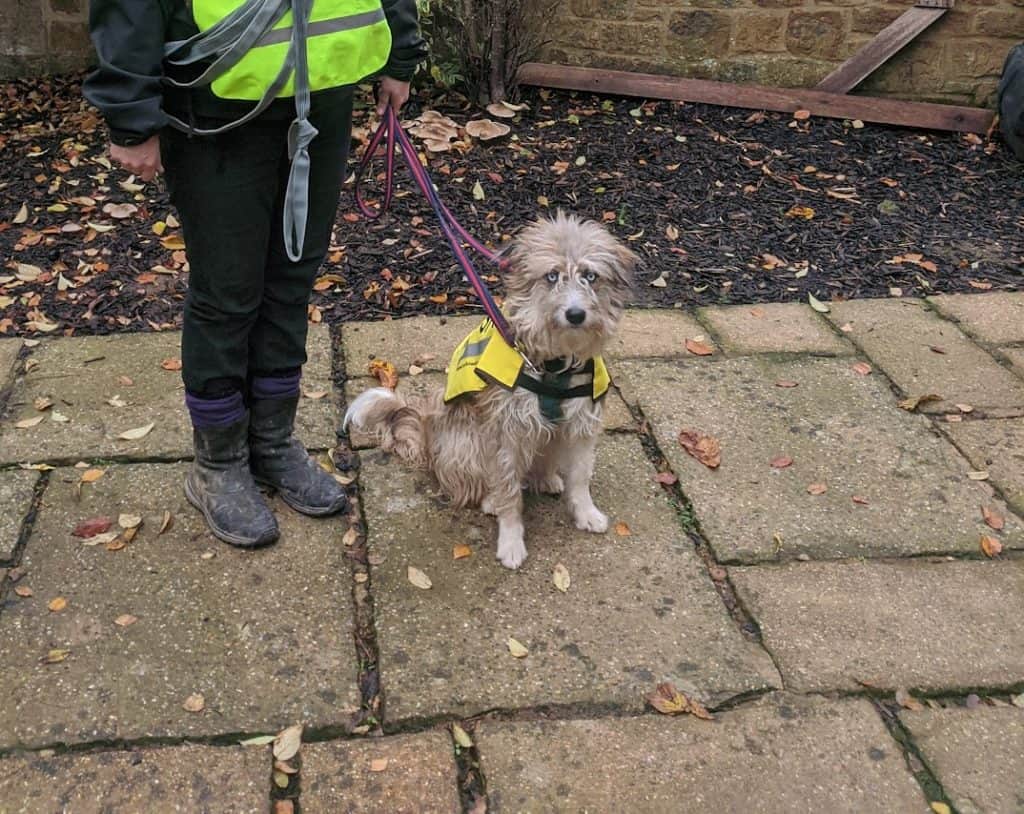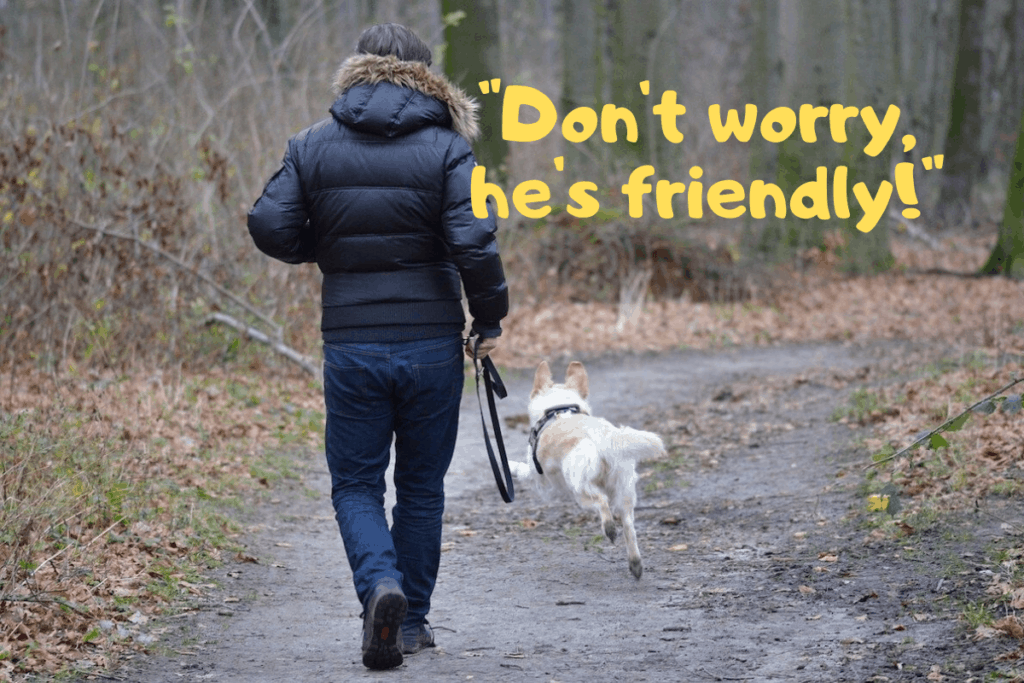I think anyone with a challenging dog can understand the anxiety this simple, well-meaning sentence can trigger.
We’ve all heard it and it strikes up fear in many dog owners for all sorts of different reasons. It’s not just a phrase that infuriates owners of reactive dogs, but those with elderly dogs; those on mediation or recovering from surgery or illness; those who are in season… the list goes on. This article really only relates to dogs being loose and out of control where and when they’re not supposed to be.
I am not a dog trainer, but you don’t need to be to know that allowing dogs to run free, unresponsive to recall in public places is the cause of a lot of issues for owners and dogs alike.
You’d be surprised at the number of dog owners who tell me that their dog isn’t at all reactive, they are just fed up with what they describe as irresponsible owners letting their dogs approach – sometimes with extreme enthusiasm when they’re out walking.
I hope this post achieves two things:
- Offers some solidarity to those dog walkers who despise being ambushed by off-lead dogs and
- Offers a little insight for those readers who may not know just how much of an issue they create when they holler the words “don’t worry, my dog’s friendly”
I’ll be honest – I really wish my dog was friendly like yours – good with kids and chums with all creatures great and small. That just wasn’t the hand I was dealt and I’m working on it and I’m not alone, so please read on.
Reasons Why Letting Your Friendly Dog Run Up To Mine is a Problem
For academic answers from animal behaviourists, you should Google this. The everyday answer is that in our case, your actions are going to cause a riot. Our bitch is reactive to dogs and people when not introduced properly, and at this point in her training, she is highly likely to go ‘over threshold’.
That means we will find it extremely difficult to calm her down and she will be very stressed. Because you thought it was ok to let your dog run up to us, you are unlikely to understand this situation and how difficult it can be. You might even tut at us or give a disapproving glance. You may have the shock of your life and apologise profusely but that’s not likely. In fact it’s very unusual to get an apology from someone who’s dog has just caused what feels to us like an international incident! You might even find out that when faced with a strange dog freaking out, your dog isn’t quite as friendly as you thought… worth thinking about. You certainly might find that her super-passive twin brother isn’t very tolerant of seeing his sister in a pickle, being upset by a strange dog and not listening when called.
How about if my bitch is in season? Your “don’t worry my dog’s friendly” dog might have a personality transformation in front of your eyes. Insatiable – our bitch is very pretty and he’d be lucky to call her his girlfriend. Except she doesn’t want his attention. There are places where people should be safe walking in season dogs. There are plenty around – places that have signage forbidding off lead dogs. The problem is, you missed the sign, didn’t pay attention or just decided the rules didn’t apply to you.
It’s pretty tricky to calm and protect a reactive dog that’s on lead, getting intently courted by a male dog whilst their owner meanders over, when I know it’s not going to be their problem if my bitch gets pregnant.
Those are our challenges – if you’re jolly cheesed off with “don’t worry, my dog’s friendly” walker – try shouting back “Maybe, but mine very definitely isn’t” and see what happens!
I’m just highlighting a few of the more common reasons below – some of you will relate and some of you will think we should have trained our dogs better. Hopefully, some of you might find a new understanding of an issue you weren’t perhaps aware of and take a new approach to your walks.
Reactive Dogs
People think they know what a reactive dog is – and there are all sorts of judgements felt by the owners of reactive dogs that only people in the same or similar situations can understand. It’s so complicated I can’t even begin to explain. To generalise, the only thing I can say is that a reactive dog will potentially experience an excitement level that flies them over the point where they are in control of their behaviour – they stop hearing. Most people would recognise this as intense barking – sometimes what might look like aggression, perhaps obvious fear and anxiety – the point is – that any dog who is on a lead having a walk might be a dog that has this as part of their personality right now. They might be in a training programme to help them cope and reduce the anxiety they feel around other dogs. They do not need you or your dog’s participation in their walk.

Elderly Dogs or Unsteady Owners
It’s not rocket science – if you’re a bit long in the tooth, unsteady on your feet or perhaps in pain – the last thing you want is an unpredictable situation occurring – one where you might lose your balance or feel a bit worried. That’s what it’s like for older dogs and elderly or infirm owners. Your rampaging ball of fluff doesn’t see the details in this situation – it’s not their fault – you need to prevent them from causing someone else anxiety.
Dogs in Recovery
As with humans – dogs need to rehabilitate after illness, injury or surgery. They also might be a bit grumpy – in pain or on drugs which make them feel a bit crappy. I was bombarded by two large dogs many years ago on our first walk outside with my dog since she was spayed. I tried to shout the field length that she was in recovery but the “it’s ok, they’re friendly” retort did not solve my problem. My problem was that not only was she stitched up and at risk of splitting the stitches, she was also dog reactive. I did what many people would in my situation and I picked her up to protect her form the onslaught. These dogs then jumped enthusiastically at me, making the entire situation worse until I screamed and screamed – the only thing that seemed to have an effect on the owner, who then ran towards us. His reaction: “you shouldn’t have picked the dog up – you totally overreacted you crazy b!7ch”. The air turned blue and I will never forget how angry that one encounter made me.
Can you imagine a situation when you dog is poorly and this kind of thing happens. You cannot control how someone might react when they’re worried about their dog – so don’t put them in that situation in the first place.
Bitches in Season
Well – this should speak for itself but we know from experience that exercising a bitch in season is quite a task. Some people go on lockdown – and I completely understand that – it’s a nightmare. I moved to my parents the first time our bitch came into season because being in a house with an intact male was unworkable. Thankfully I had this option. Not everyone has the luxury.
So there will be people you come across occasionally who are walking a dog in season. Having a “it’s ok, he’s friendly” dog loose in this situation is a recipe for disaster. A motivated dog will move heaven and earth to reach a bitch in season – and once they’re in contact, the worst isn’t an unwanted litter, it can be far nastier for an unreceptive female. Just think about that.
Assistance Dogs, and Those in Training
Not all assistance dogs in training wear capes. Not all assistance dogs wear capes. Can you tell from half a field away whether someone is deaf or partially sighted? I know I can’t. Can you tell if a dog on a lead is offering a vital emotional crutch to a child with autism? Nope? Didn’t think so. Can you tell if a German Shepherd or a Malinois walking obediently to heal is a pet or a protection dog in training? Minding their own business. Having a school outing. Doing their job. No time for unscheduled arsing around with your dog.
So now that I’ve got that out of my system, here’s what we, on behalf of dog owners everywhere ask.
What To Do (and What Not To Do)
- Please never ever use that phrase. It may have unintended consequences – people are usually good at reading the signs, and if a dog is on the lead, so should yours be. That sentence certainly unleashes a fire in my belly.
- Don’t ignore signs that forbid dogs to be lose. It is the only place some people have the reassurance they need that their dog will not interact with other dogs.
- Think about other people. You have no idea what their situation is or that of their dogs and so giving people space is just common courtesy.
- I’m pretty vocal. If there’s a dog off the lead approaching and I have an alternative route to walk, I take it – I don’t want to disrupt someone’s walk because my dog is challenging. But sometimes there is no alternative so I stop. I also have a great big neon tabard that you can’t mis stating that ‘My Dog Needs Space’. If that doesn’t prompt a recall, I ask if they can get hold of their dog. I don’t necessarily expect them to be on lead but I do expect them to be in absolute control. If you want to try one of these out, I can highly recommend them and you can find them here on Amazon – Human High Vis and Dog Vest in lots of sizes – you can also get leads and bandanas and various other accessories to drive the message home!
- Communicate if you can – I’m trying to tell you something. I don’t want a scene, I don’t want any drama. I just want to get past you without my dog getting stressed.
- Keep your eyes peeled. Some people with reactive dogs wear tabards, some dogs will also have a sunshine yellow collar or jacket – look out for it as it’s a sure sign they’re not going to want to play with your dog.
- Don’t judge. Our dogs are family – we all want the best for them. You don’t get to decide what that is.
- And try to understand.
I hope that offers a little insight from someone who lives with a reactive dog in rehab!

